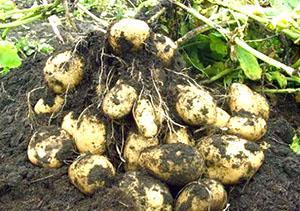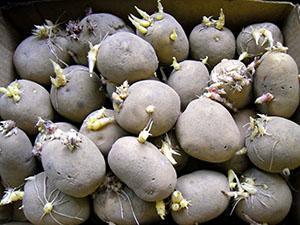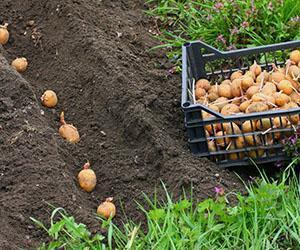Planting and caring for potatoes in the open field
 Potatoes are a favorite plant of many summer residents. New cultivation methods make it possible to simplify the work of the gardener and at the same time not to lose in the harvest. The modern technology of potato cultivation is more like an art that is not difficult to master. So, let's talk about potatoes, planting and caring for them in the open field.
Potatoes are a favorite plant of many summer residents. New cultivation methods make it possible to simplify the work of the gardener and at the same time not to lose in the harvest. The modern technology of potato cultivation is more like an art that is not difficult to master. So, let's talk about potatoes, planting and caring for them in the open field.
Preparatory work before planting potatoes

- Before planting potatoes, it is useful to disinfect the planting material.
- Preparatory work is being carried out on the site for potatoes.
- For more active growth of roots and sprouts, additional cuts are made throughout the potato tuber.
Disinfection and feeding... Potato tubers are disinfected with potassium permanganate, boric acid or garlic infusion. This can serve as a stimulant for the growth of healthy shoots, and also protect the plant from pests in the future. What is the best way to do this? One of two ways: soaking (2 hours will be enough) or spraying.
Spraying potatoes is done only when the sprouts have not yet appeared on the tubers!
You can buy special solutions in the store, but you can also make them yourself. Here are some recipes:
- take 10 g of boric acid, 50 g of urea and superphosphate, 1 g of potassium permanganate and 5 g of copper sulfate;
- Mix 10 liters of water with crushed kilogram of garlic (this solution is suitable for both spraying and soaking);
- mix half a gram of potassium permanganate with 5 grams of copper sulfate and 15 grams of boric acid. Pour all this with water (10 l).
Soil preparation... The main requirements for the quality of the soil in the area where the potatoes will grow are air permeability and friability. Before planting potatoes, the land is cultivated twice:
- In the fall, digging a vegetable garden with the introduction of rotted manure into the soil.
- In the spring, embedding a mixture of peat and sand in the soil, at the rate of 10 kg per 1 sq. m.
Tuber incisions... There are several types of cuts:
- Transverse. Deep cut, not cutting only 1-1.5 cm to the end of the tuber.
- By diameter. This type of incision is also called stimulating, it can be both diagonally and vertically. Shallow, only 0.5-1 cm.
Thanks to such incisions, those shoots that usually "sleep" begin to actively develop. It will be enough to keep the cut potatoes for a month at a temperature of 16-18 degrees, so that strong, evenly developed roots and shoots appear on it. Read also:recipe for potato pancakes with photo step by step!
Planting potatoes
 There are several ways to plant potatoes:
There are several ways to plant potatoes:
- trench;
- smooth;
- comb.
Trench... This method is great in warm climates, provided the soil is light, sandy, and does not hold moisture. In this case, it will be correct to dig trenches under the potatoes, 10-15 cm deep, the distance between which is 70 cm. The tubers are laid out in them taking into account their size: large ones every 40 cm, small ones - 30-35.
Sometimes for this type of planting, summer residents prepare small ditches in advance, even in the fall (this method excludes the autumn digging of the earth).Digging trenches to a depth of 5-10 cm, they make a kind of "pillow" of organic matter: straw or other plant residues with rotted manure, and all this is covered with earth. In spring, potatoes can be planted in these ditches earlier than usual, because decaying organic matter will warm the soil faster.
Smooth. For this type of planting, you just need to raise a layer of earth, put the potato tuber sprouts up, and sprinkle it with soil. This simple method is a great solution for well-lit areas without stagnant water. A kind of "holes" are made at a distance of 60-70 cm to a depth of half a shovel. Landing is carried out in two ranks, in a checkerboard pattern. This will facilitate inter-row cultivation of the potatoes in the future when sprouts appear.
Ridge... If the soil on the site is "heavy", waterlogged, this method is suitable. At a distance of 70 cm from each other, ridges 10-15 cm high are made, in which potato tubers are planted at a distance of 30 cm. This helps the excess moisture to erode faster.
Basic rules for planting potatoes:
- Traditionally, it is customary to plant potatoes in early May.
- The site should be sunny, without stagnant water.
- The direction of the planting ridges is from the north to the south; this will make it possible to evenly illuminate and warm up the rows of potatoes.
The method and scheme of planting is selected based on the specific conditions under which the plant is comfortable to develop and bear fruit. Then it is much more convenient to care for the fit, and more significant results are obtained.
Proper care of potatoes after planting
Potato tubers sprouted according to all the rules give healthier sprouts. However, it is possible that the plant needs further care. Caring for potatoes after planting involves several stages:
- watering;
- hilling;
- fertilizer;
- protection.
Watering
 Watering is one of the important factors affecting potato yield. If summer is not dry, then 3 waterings are enough. But you need to do it right and on time. There is no need to water immediately after planting as the soil still contains spring moisture. But, when the tops begin to grow actively, and this is half a month after the emergence of shoots, the plant is in dire need of additional moisture.
Watering is one of the important factors affecting potato yield. If summer is not dry, then 3 waterings are enough. But you need to do it right and on time. There is no need to water immediately after planting as the soil still contains spring moisture. But, when the tops begin to grow actively, and this is half a month after the emergence of shoots, the plant is in dire need of additional moisture.
The flowering process of the potatoes shows that the formation of tubers has begun, which means it is time to water again. The third watering will depend on how dry the soil is. If, it is firm, does not stretch well in the hand, and is dry at a depth of 6 or more centimeters, then it needs moisturizing. The next day or every other day, depending on the drying out of the soil, it is necessary to loosen the soil. Or you can spread mulch on still wet soil, which also helps to preserve moisture in the soil.
 What to choose? Sprinkler method or drip irrigation? Many summer residents see the advantage of each type of watering. For example, if it is possible to install sprinklers for a day or more, it seems to replace light rain, when not only the soil is moistened, but also washes the dust from the leaves and stems. With drip irrigation, more water will go under the bush.
What to choose? Sprinkler method or drip irrigation? Many summer residents see the advantage of each type of watering. For example, if it is possible to install sprinklers for a day or more, it seems to replace light rain, when not only the soil is moistened, but also washes the dust from the leaves and stems. With drip irrigation, more water will go under the bush.
Hilling
Inter-row cultivation of potatoes is very important. It can protect young plants from possible frosts, remove weeds, provide moisture accumulation and air flow to the roots, and stimulate the growth of green mass and roots.  It turns out that hilling is an important part of plant care, since the yield directly depends on it. The first loosening between the rows can be done as soon as young potato shoots appear. In the future, hilling should be done every time after rain or watering, and before flowering.
It turns out that hilling is an important part of plant care, since the yield directly depends on it. The first loosening between the rows can be done as soon as young potato shoots appear. In the future, hilling should be done every time after rain or watering, and before flowering.
There are several ways of hilling - mechanized: with a walk-behind tractor, and manual: with a hoe, a hiller, a flat cutter.
Fertilizer
 Potatoes respond well to mixed feeding, both organic and mineral fertilizers.You can even plant potatoes by adding ash or nitrophosphate (1 tablespoon per well).
Potatoes respond well to mixed feeding, both organic and mineral fertilizers.You can even plant potatoes by adding ash or nitrophosphate (1 tablespoon per well).
It is recommended to feed potatoes three times per season. Moreover, this is done for the first time when the tops are still young and developing. To do this, 1 tbsp is diluted in a bucket of water (10 l). urea. Or bring in a semi-liquid mullein. At least 0.5 liters of any of the solutions per bush. Fertilize only after rain or watering.
The second mandatory feeding during budding is designed to speed up the flowering process. To do this, you need 3 tbsp for a bucket of water. tablespoons of ash and 1 tbsp. tablespoons of potassium sulfate.
Superphosphate in granules is perfect for feeding potatoes during flowering. Thanks to this fertilizer, a solid root system develops, the formation of tubers is accelerated (for 10 liters of water you need a glass of semi-liquid mullein and 2 tablespoons of superphosphate).
Protection
 Ash not only fertilizes, but also perfectly protects potato bushes from rotting in wet weather. Therefore, you can not only water the plants with a solution of ash, but also trim the tops with it. The same method helps to fight against the main enemy of the potato - the Colorado potato beetle.
Ash not only fertilizes, but also perfectly protects potato bushes from rotting in wet weather. Therefore, you can not only water the plants with a solution of ash, but also trim the tops with it. The same method helps to fight against the main enemy of the potato - the Colorado potato beetle.
Onion peels are also widely used from natural remedies. It can be added to the holes when planting potatoes, and mulch planting with it, sprinkling around the plants. Planting legumes, calendula, or mustard in or around potatoes will help keep wireworm away from root vegetables.
Garlic infusion will help with late blight. Grind 200g of garlic until mush, add a little water and let it brew for 2 days. Then mix this infusion with 10 liters of water and you can process the plants. This should be done 2-3 times with an interval of 10 days.
There are other means of protecting potatoes from diseases and pests. For example, the mechanical collection of the Colorado potato beetle and its larvae, or chemical preparations.
Harvesting
Probably the most pleasant thing is to see the fruits of your own labor. So harvesting potatoes is more than an objective assessment, it is an opportunity to learn the lessons that will come in handy for the next potato planting.
Tips for growing potatoes outdoors
- Only healthy tubers are selected for planting.
- At least 10 days before planting, the planting material is transferred to a warm place.
- It is imperative to plant potatoes in the soil warmed up to 8˚ or more.
- Watering should be done only in the evening, so that the moisture on the leaves has time to dry out by morning.
- Loosening the soil after watering should be done as early as possible.
- Breaking the stem from the ground at a distance of 15 cm is a method that allows the tops to not develop after flowering. Then the potato bush concentrates all its power on the roots.
- Watering stops 3-4 weeks before harvest.
Watch the video on how to plant potatoes correctly.
Thanks for the information that can benefit many summer residents. I discovered for myself that potatoes need to be cut for active germination. Until now, this method has not been seen anywhere in the literature. And I also learned something new for myself, after flowering, break the stems in the bush so that the development does not go to the green mass, to the filling of the tubers. Also read about it for the first time. In general, there is a lot of useful information in the article. No chemical abuse. Ash, organic matter is used more for fertilizing. Even the methods of dealing with the Colorado potato beetle and wireworm are sparing so as not to introduce unnecessary pollutants into the ground. In general, the article inspires confidence in the advice set out in it. But I personally don't like sprinkling in the evening. It seems that phytophthora will be comfortable on a wet leaf blade under conditions of low night temperature.